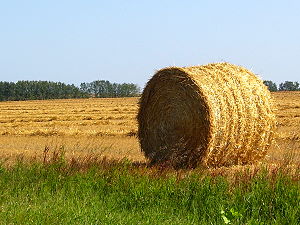 Northwest Region Crop Report Prepared by: Manitoba Agriculture
Northwest Region Crop Report Prepared by: Manitoba Agriculture
October 20, 2020 |
Northwest Region
The 2020 growing season was a challenge through most of the region, largely due to extended periods of spring insect pressure, strong winds, lack of precipitation, and dry soils post seeding. These crop impacts caused multiple reseeding efforts around Swan River and Roblin. The challenge at The Pas was good crop emergence and then ongoing heavy rains drowning crop in low-lying areas and challenges with timely herbicide operations.
Seeding was well underway by the second week of May and generally complete by the 26th of May. Spring seeding conditions were good in the Northwest region with early seeded cereals and canola emerging well. However, timely rains were a problem and dry soils affected a major portion of the region. These dry soils along with several severe wind events caused emerged crops to be sheared off, wind blasted, twisted, seed blown away and some parts of fields covered with excessive soil. Earlier seeded canola was able to take advantage of soil moisture but was impacted by frost events, intense, ongoing flea beetle pressure and later, the same dry soil conditions. Some fields were reseeded, sometimes multiple times, and did not emerge until moisture conditions were adequate. While cereals did recover better, the reseeded and later emerging canola fields were patchy and stagey and they did not fully recover from the spring conditions. Wind events continued and these strong winds caused significant problems with timely pesticide application.
There were hailstorms this season around Roblin and Swan River at various times during the summer with damage ranging from minimal to significant. Issues with germination, emergence, frost, insects and dry soil conditions became visible and caused staginess in the crop. This variety of staging became a challenge for harvest. Hot temperatures and winds during flowering caused aborted flowers on canola flowering during this period. As well, the later seeded canola was impacted by frost events leading to green seed issues and downgrading.
As far as insects in the region in 2020, flea beetles continue to be an issue and with the dry conditions, pressure continued well in to June. Canola that did emerge had to be sprayed several times to protect it until it reached a stage to withstand the feeding pressure. Cutworm feeding also contributed to many reseeded crops. Grasshoppers were a concern in some areas of the region as well.
The variable moisture caused rapid changes to the fusarium risk map for the region however; varied growth stages and windy conditions caused challenges for timely application of fungicides. Sclerotinia was not significant this season due to dry conditions (but was present). Blackleg and verticillium seemed to set in later in the season and caused lodging. Disease impacts were variable with some fields very affected, while some others saw no impacts at all.
The 2020 harvest is generally complete in the Northwest region. The season was a challenging one with wet conditions in the northern part of the region, dry soils, several wind events, insect pressure and lack of timely precipitation through most of the region. Field pea harvest operations are complete with yields averaging 50 to 90 bu/ac and grading 2 CAN in the Swan River and Roblin areas. The red spring wheat harvest is complete in the region with average yields for CWRS class wheat at 60 to 90 bu/acre. Grades range, with 70% of the crop grading № 1 CW, 25% grading № 2 CW and the remainder grading lower. There are some reports of low protein levels. Spring Wheat is grading better in the southern part of the region. Oats yielded 110 to 130 bu/acre and 80% are grading 2 CW with the remainder grading 3 CW. Barley yields averaged 85 bu/acre and are grading 2 CW. The canola harvest is virtually complete with approximately 99% of the acres combined. Canola yields averaged 40 to 60 bu/ac. The quality of canola harvested is standard for the region with 90 to 95% of the crop grading 1 CAN and the balance 2 CAN. Soybeans are harvested with yields averaging 35 to 40 bu/ac; 100% of the crop is grading 2 CAN.
With some exceptions, currently soil moisture conditions are rated as dry. These dry soil moisture conditions have limited fall tillage operation due to concerns of soil erosion. Some anhydrous (and dry fertilizer) has been applied, though less anhydrous ammonia applied to due concern for loss.
Hay production across the Northwest region varied yielding 33% of average to average depending on moisture received, management and age of stand. Producers short on hay are exploring options to makeup up the shortfall including feeding straw in early and mid gestation. Straw and feed grain supplies are adequate. Greenfeed and annual cereal silage crops performed well yielding average to above average. Corn silage yields ranged from below average to above average with varying amounts of moisture received and differences in seeding dates.
The early September frost also affected yield with leaf loss and reduced cob development. Pasture conditions deteriorated after the September frosts thus requiring supplemental feed or herds being moved to extended grazing sites earlier than normal. Dugouts are low, particularly in the Ethelbert, Rorketon and Eddystone areas where some have dried up. In addition, in the Swan River area, there is fear that the surface wells and dugouts will not be able to sustain herds over the winter. Little to no rainfall in late summer and fall has created dry conditions and producers are concerned for next season’s forage growth and water supplies.
